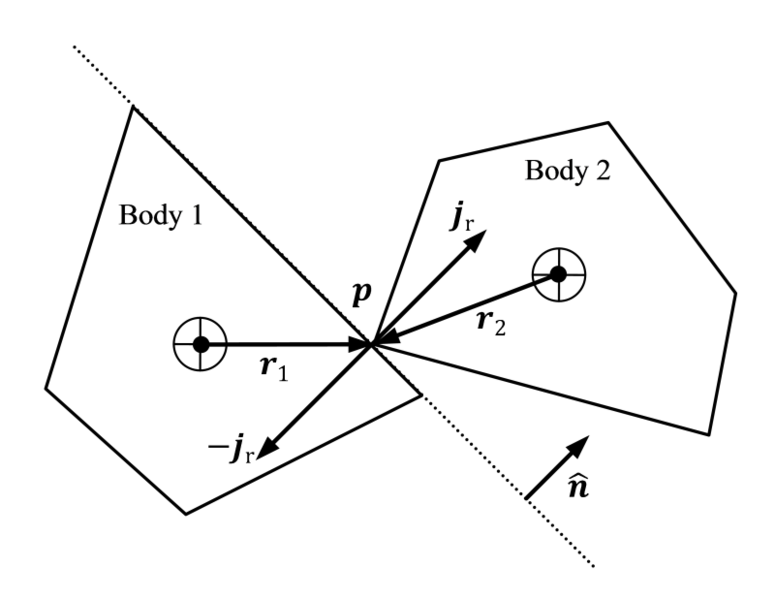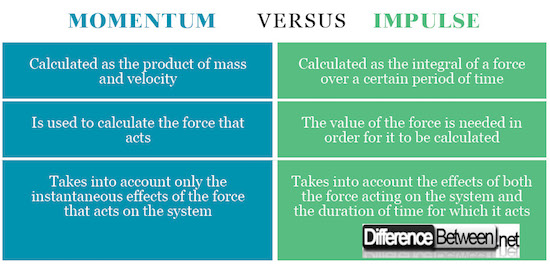Difference Between Momentum and Impulse
Momentum and impulse are both terms that describe concepts in physics that are relatively similar. Most of the confusion arises from the fact that both of these concepts have the same units – mass times velocity. However, they are fundamentally not the same, and are calculated in different ways.
Both momentum and impulse are concepts from classical mechanics, a branch of physics that revolves around the Newton’s second law of motion. However, while the momentum of an object is calculated as the product of mass and velocity of that object, the impulse represents the change of momentum of a system over a certain period of time. This results in both concepts having the same units, but completely different meanings, describing completely different phenomena and being calculated in two completely different ways.
What is Momentum?
In advanced formulations of classical mechanics, you can use something called “generalized momentum”. The value of the generalized momentum doesn’t depend on a coordinate system or other constrains. You can then further define other mathematical structures, such as Lagrangians or Hamiltonians, in order to describe how to calculate the kinetic momentum from the generalized one, with a specified coordinate system and any additional physical constraints.
However, these are highly technical definitions of momentum that differ from the common ones. Therefore, for the sake of clarity, this article will focus solely on the kinetic momentum, or, in most cases, just the term momentum in general.
Momentum, in this sense, is a vector that can be calculated by multiplying the mass of an object with its velocity (which is also a vector and the reason momentum is a vector as well). Its SI unit is kilogram meter per second, and it plays a crucial role in calculating the force from Newton’s second law of motion, because the force is equal to the rate of change of momentum. If a system of more than one body is regarded, you can calculate its momentum by calculating the momentum of each individual particle in that system and then adding them together as vectors. The resulting vector will be the momentum of the entire system.
What is Impulse?
Impulse, in technical terms, represents an integral of a force over a certain time interval, which is basically calculating the area under the graph of the force from one point in time to the other. Another way to represent impulse is as a change in the momentum of a body or a system of bodies.
For example, if you were pushing a box of a certain mass, and you were pushing it with constant force for two different periods of time, the change in momentum (in other words – impulse) would be larger in one case than it is in the other, because you applied the force for a longer period of time. However, the impulse could be the same no matter if you act for 5 or 10 seconds.
For example, if you apply a small force over a long period of time or a strong force over a smaller period of time, you can do the same effect, and the object you applied that force on would have the same momentum change, and therefore the same impulse. This is the most common example that is used to describe how momentum and impulse are fundamentally not the same thing. The SI units of an impulse is the newton second. However, since newton is really kilogram meter per second squared, when you combine those definitions you’ll find that the unit of impulse is kilogram meter per second, and that impulse really has the same SI units as the momentum – which is a consequence of impulse really representing a change in momentum.
Difference between Momentum and Impulse
Calculation for Momentum vs. Impulse
The way you calculate each is completely different. You calculate the impulse of an object by multiplying its mass with its velocity, while you calculate the impulse of an object by calculating the integral of a force over a period of time, or, alternatively, by calculating the change in the momentum of a body. This also applies to any systems of more than one body, you would just need to calculate the sum of all the vectors.
Connection to force
As was mentioned above, the impulse is an integral of a force, so it can be calculated directly by knowing the force, while the momentum is used to calculate the force itself.
Considered effects of Momentum vs. Impulse
Impulse takes into account two things – both the force that acts on a system and the duration of time for which that force acts. However, momentum only gives the instantaneous effects of the action of force on a system, in terms of the product of mass and velocity, without providing any knowledge about how that force has acted in the past.
Momentum vs. Impulse
Summary of Momentum vs. Impulse
- Momentum and impulse are concepts in physics and classical mechanics that are used to describe different features of moving bodies
- Momentum is calculated as the product of mass and velocity, while impulse is calculated as the integral of a force over a period of time for which it acts
- The main difference is in how they are calculated, what they represent and what they inherently take into account.
- Difference Between Kinetics and Kinematics - March 16, 2018
- Difference Between Correlation and Association - March 13, 2018
- Difference Between Momentum and Impulse - March 8, 2018
Search DifferenceBetween.net :
2 Comments
Leave a Response
References :
[0]Zarankin, Ilya. "Momentum and Impulse."
[1]Watson, Keith L. "Momentum and Impulse." Foundation Science for Engineers. Macmillan Education UK, 1998. 54-59.
[2]Celia, C. W., A. T. F. Nice, and K. F. Elliott. "Momentum and impulse." Advanced mathematics 2. Palgrave, London, 1982. 300-324.
[3]Image credit: https://upload.wikimedia.org/wikipedia/commons/thumb/7/7c/Angular_momentum_bivector_and_pseudovector.svg/640px-Angular_momentum_bivector_and_pseudovector.svg.png
[4]Image credit: https://upload.wikimedia.org/wikipedia/commons/thumb/8/88/Collision_response_rigid_impulse_reaction.png/775px-Collision_response_rigid_impulse_reaction.png




Thanks for this but i think you have to focus on the main topic which is difference between momentum and impulse….i found it later but differences are good….every user does not see at last…..i hope you understand….once again thnku..
Here is one mistake.on the fourth line of calculation formula of momentum and impulse you have written impulse in place of momentum.correct it